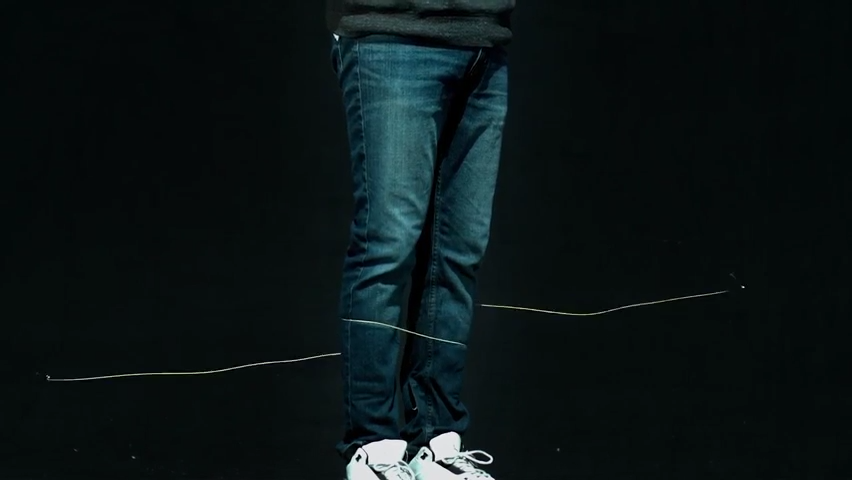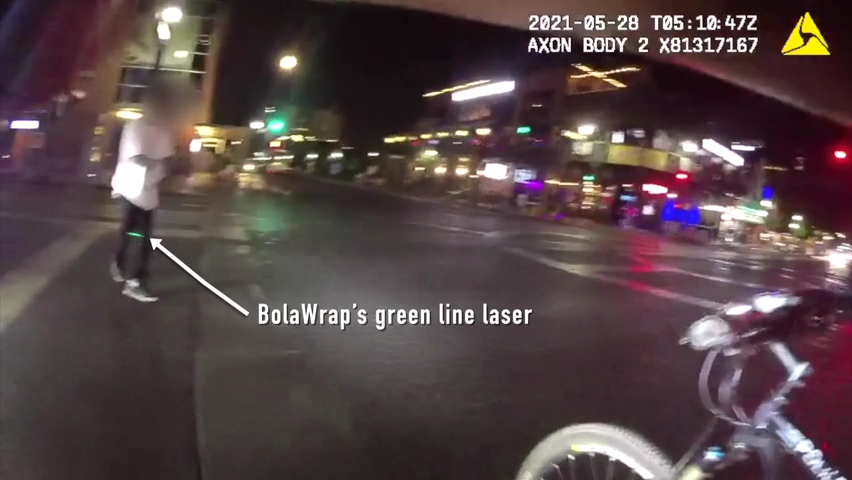Arizona law enforcement using new tool that can stop people by wrapping their arms, legs

PHOENIX – Several Arizona law enforcement agencies are among hundreds across the country testing a new de-escalation tool straight out of a comic book that's intended to help them stop and detain people without causing pain.
De-escalation tactics came into prominence within the last 10 years when police use of force came under the "microscope," said Kevin Robinson, lecturer at Arizona State University's School of Criminology and Criminal Justice and former assistant Phoenix police chief.
"It's not that it has not always been taught – it has – but there has never been as much of an emphasis as there is on it as there is now," he said. Robinson worked with the Phoenix Police Department for 36.5 years, serving 13 as an assistant police chief.
Throughout the decades, there have been various practices pertaining to police de-escalation tactics, including "verbal judo" and stun guns including Tasers.
Now, another product has come to public attention: the BolaWrap remote restraint device.
The de-escalation tool was created about four years ago, according to Tom Smith, CEO and president of WRAP Technologies, which is headquartered in Tempe, Arizona.
Previous coverage: Police are looking for alternatives to guns. How effective are they?
The BolaWrap is hand-held like a Taser, but is shaped more like a cellphone and, once it is activated, it discharges an 8-foot Kevlar cord to "restrain uncooperative suspects or nonresponsive persons in crisis from a distance," according to its website.
Smith said the BolaWrap is the only tool available to law enforcement that does not rely on pain compliance.
"Whether it's pepper spray, baton, taser, ultimately a firearm, all of those rely on inflicting pain on the subject when the tool is being used where this tool doesn't do that," he told The Arizona Republic, a part of the Paste BN Network.
Unlike the Taser, which relies on electric currents to subdue people, the BolaWrap utilizes a cord that wraps around people once shot from the device. According to the WRAP Technologies website, the BolaWrap is classified as a "less-lethal weapon."
Smith, who co-founded TASER International (now Axon Enterprise), said the product is meant to restrain individuals without using pain, giving police the opportunity to take them into custody without force.
Police use of force has come into question within recent years, especially since the murder of George Floyd in Minneapolis in 2020.
The number of shootings is roughly the same as the statewide average for the 10-year period measured by The Republic. The number still trails 2018 when Arizona police shot people in 118 different incidents, the most the state had seen in a single year since at least 2011. That year, Phoenix police shot 47 people and had the highest rate of any municipal police department in the country.
"Law enforcement agencies that want to move forward in a positive way, they look for opportunities not to use force," Robinson said.
Police test BolaWrap on man
On May 28, Tempe police used the BolaWrap on a man who was running through traffic , appearing to be in crisis and armed with a stun gun, according to WRAP Technologies.
Body camera footage from the deployment shows a man walking in and out of traffic as Tempe police officers tell him to "get on the sidewalk."
'We are now the devil': With COVID and Floyd aftermath, New Jersey cops say they're burned out
One of the officers asks to see the man's ID when he takes out a stun gun and points it at people who are walking.
In the footage, the man continues walking despite being told to stop by officers and the first officer says "I'm gonna Bola."

The BolaWrap's green laser line is seen on the man's legs and as the man continues to walk, the officer deploys the BolaWrap, restraining the man from walking any further.
The man looks down at his knees, which are now wrapped like something out of a Spiderman movie. The edited video then jumps to when the man raises his hands over his head and an officer handcuffs him and removes the wrap with medical shears. Police say the man was not injured.
In regard to the deployment, Tempe Chief of Police Jeffrey Glover said in a statement, “The Tempe Police Department is training constantly to improve our de-escalation and resolution efforts. We strive to be very attuned to individuals that may be suffering from mental illness or dementia, disoriented, or potentially impaired.
"The BolaWrap technology tool gives us a greater array of options – especially in situations such as occurred here, on a busy night in downtown, when the individual was not responding to our Officers’ directions, and unaware that he was putting others and himself at risk amid vehicle traffic.”
Police reform: Tishaura Jones wants to reimagine policing in St. Louis. With rising crime and a push to 'defund,' can she do it?
BolaWrap meant to be used in crisis situations not involving threat of serious injury
Smith said the BolaWrap is meant to be used in situations of crisis intervention where someone is "not acting rationally" whether that be due to mental health, alcohol, drugs, or any other reason.
"(Law enforcement) can use the BolaWrap early in that confrontation where they are not posing a threat to injure themselves, the officer or others," he said. "End that confrontation before it escalates to those higher levels of force or pain compliance tools without having to hurt them or put them at risk."
According to the BolaWrap website, the product is a diversionary tool to distract someone in crisis while officers take them into custody. The BolaWrap emits a gunshot-like sound once deployed and this is meant to surprise the person and take their attention away from officers so they submit.
Smith added that it was "satisfying" to see the product used in the company's hometown and that the BolaWrap can help with many department's de-escalation tactics.
"Police have been under a lot of pressure over the last 12 or 14 months with everything going on in the world; being able to use a tool like this so that it doesn't escalate, it doesn't become that next viral video, that's really what we are trying to do here," Smith said.
WRAP Technologies has a training program for agencies that want to use and implement the BolaWrap, called the "Train the Trainer" course.
The five-hour course, consisting of a three-hour classroom session and a two-hour field session, trains officers as instructors so they then can go to their agencies to come up with a policy on how and where to use the BolaWrap, relative to other equipment they have, Smith said.
"We are constantly working with law enforcement instructors and trainers to make sure that they understand the equipment and then can incorporate it effectively to their policy on how it will be used by the officers and they do the training," he said.
Nine Arizona agencies among 500 in the U.S. using new tool
In the U.S., according to a 2020 press release, agencies including Cincinnati Police Department in Ohio, Gary Police Department in West Virginia and Novato Police Department in California are using the BolaWrap with the product only being available to law enforcement for two years. The BolaWrap has also shipped internationally to 44 countries.
In Arizona, the following agencies are in various stages of testing and use, according to WRAP Technologies: Arizona Department of Public Safety, Avondale Police Department, Glendale Police Department, Goodyear Police Department, Lake Havasu Police Department, La Paz County Sheriff's Office, Maricopa Police Department, Sahuarita Police Department and Tempe Police Department.
"It is not just a domestic problem, all police around the world are facing similar issues," Smith said, adding that the company's goal is to get every front-line officer to carry the BolaWrap.
David Jones, a sergeant with the Avondale police department in charge of training, said his department has had the BolaWrap in the field since early 2020.
Within the department's nine patrol squads, one BolaWrap is assigned to each squad. Avondale police have deployed the BolaWrap once on a person who was in crisis mode, threatening to kill themselves.
During that incident, officers were able to de-escalate the situation and restrain the man at his ankles with the BolaWrap.
"For us, it just gives us another tool, another less-lethal tool, to go to," he said. "The one time we did deploy it, it was a good deployment as far as successful for us."
Jones said his department teaches officers about the BolaWrap and its proper usage, practicing on a training mannequin, and they must do two practice deployments to be certified to use. These proper deployments are from the wrist to the elbows and from the knee to the ankle, Jones said.
Officers are trained not to deploy the BolaWrap above the elbow area, according to the BolaWrap website.
The Avondale officers are then recertified every year to use the BolaWrap, Jones said.
BolaWrap has potential to injure people
While the BolaWrap has had its success, the product is not flawless.
The BolaWrap has a green laser line for "precise accuracy" that can be seen on a person's body before deployment. Once shot, the BolaWrap travels at 640 feet per second.
Jones said the BolaWrap does have "capacity for injury" as a result of the hooks that are on the cord.
If someone is not wearing clothing or skin is exposed, the BolaWrap can still wrap but the small hooks at the end of the tether may penetrate into skin.
The BolaWrap can still work and potentially wrap someone’s legs if they are running, but the likelihood of a successful wrap may decrease. The BolaWrap's range is 10 to 25 feet, according to WRAP Technologies.
ASU instructor: De-escalation tools alone will not solve police issues
Robinson said it's important to give law enforcement as many tools as possible to help them deal with critical situations but things don't always work as planned in real life.
"Not every situation is as constant as we saw in the videos," said Robinson. "There are going to be situations that are going to be very fluid; people are going to be running around and it may work in some cases but there are some cases it may not work."
Jones said the BolaWrap has given Avondale police another option to consider when it comes to use of force.
"It gives us something else to think about," he said. "It's not practical for every situation but I think it is dependent on situations where it may be dealing with someone in a mental health crisis."
Robinson said de-escalation tactics have always been an important part of law enforcement but it is up to the agencies and the leadership within them to really make a change.
"Right now, law enforcement in the United States is at an inflection point," Robinson said. "There has to be a greater understanding of what we want law enforcement to do. If they are not properly trained with the situation, then things can go wrong."
Although de-escalation tools such as Taser and BolaWrap keep emerging, they will not solve police issues alone, Robinson said.
"I think it's good to have as many tools as you possibly can but there is no guarantee because you have that tool that it is going to be impactful or effective," he said.
Follow Olivia Munson on Twitter @munson_olivia.